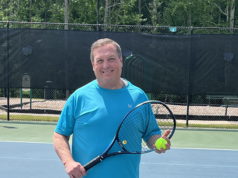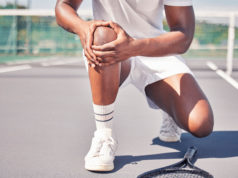By Mark Kovacs, PhD, CSCS, FACSM, CTPS, MTPS, Kovacs Institute
Tennis is a sport that demands peak physical and mental performance. However, when the cold weather sets in, playing tennis becomes an entirely different challenge. As the weather starts to cool, let’s explore how the body responds to the cold and what you can do to maintain optimal performance under frigid conditions.
Cold weather’s impact on the body
When exposed to cold weather, the body undergoes several physiological responses to maintain core temperature and overall function. These responses can significantly affect tennis players:
- Vasoconstriction: In response to cold, blood vessels constrict (vasoconstriction) to reduce blood flow to the extremities and retain heat in the core. This can lead to reduced circulation in the hands and feet, potentially affecting a player’s grip and dexterity.
- Muscle stiffness: Cold weather can cause muscle stiffness and decreased flexibility. This stiffness may hinder a player’s ability to move quickly and perform explosive movements, such as rapid changes in direction and powerful shots.
- Decreased sensation: Cold temperatures can reduce tactile sensation in the fingers, making it challenging to feel the racquet handle and control shots accurately.
- Increased energy expenditure: The body burns more energy in cold conditions to maintain its core temperature. Tennis players may find themselves fatigued more quickly, affecting their overall endurance on the court.
Mitigating the impact of cold weather
While cold weather presents physiological challenges for tennis players, there are strategies to mitigate its impact and optimize performance:
- Proper warmup: A comprehensive warm-up is crucial in cold weather. It helps increase muscle temperature, blood flow, and flexibility. Dynamic stretching and light aerobic exercises can prepare the body for the demands of tennis in the cold. Attempt to break a sweat before stepping on the court.
- Layered clothing: Dressing in layers allows players to regulate their body temperature effectively. Start with a moisture-wicking base layer to keep sweat away from the skin. Add insulating layers to retain warmth, and finish with a windproof and waterproof outer layer to shield against the elements.
- Hand and foot protection: Keeping hands and feet warm is essential. Players can wear thermal gloves designed for sports, use hand warmers, and invest in tennis-specific socks that provide warmth.
- Maintaining hydration: Cold weather can lead to reduced awareness of thirst, but hydration is just as crucial as in warmer conditions. Drinking warm fluids, such as herbal tea or warm water with lemon, can help maintain internal body temperature and hydration levels.
- Nutrition: A balanced diet rich in carbohydrates, proteins, and healthy fats provides the necessary energy to combat the increased energy expenditure in cold weather. Carbohydrates are vital for sustaining endurance during long matches.
- Adapted game plan: Adjusting one’s game plan to the conditions is essential. Players may opt for a more controlled and patient style of play, focusing on consistency rather than power and aggression, which can be compromised by the cold.
- Mental toughness: Playing in cold weather requires mental fortitude. Players should prepare mentally for the challenges they may face, stay focused on their goals, and not allow discomfort to affect their concentration.
Conclusion
Playing tennis in cold weather presents unique physiological challenges that demand careful preparation and adaptation. Understanding how the body responds to the cold and employing strategies to mitigate its effects are key to maintaining peak performance on the tennis court. By focusing on proper warm-up routines, clothing choices, nutrition, and mental toughness, tennis players can excel in frigid conditions and continue to enjoy the sport, even when the temperatures drop.




